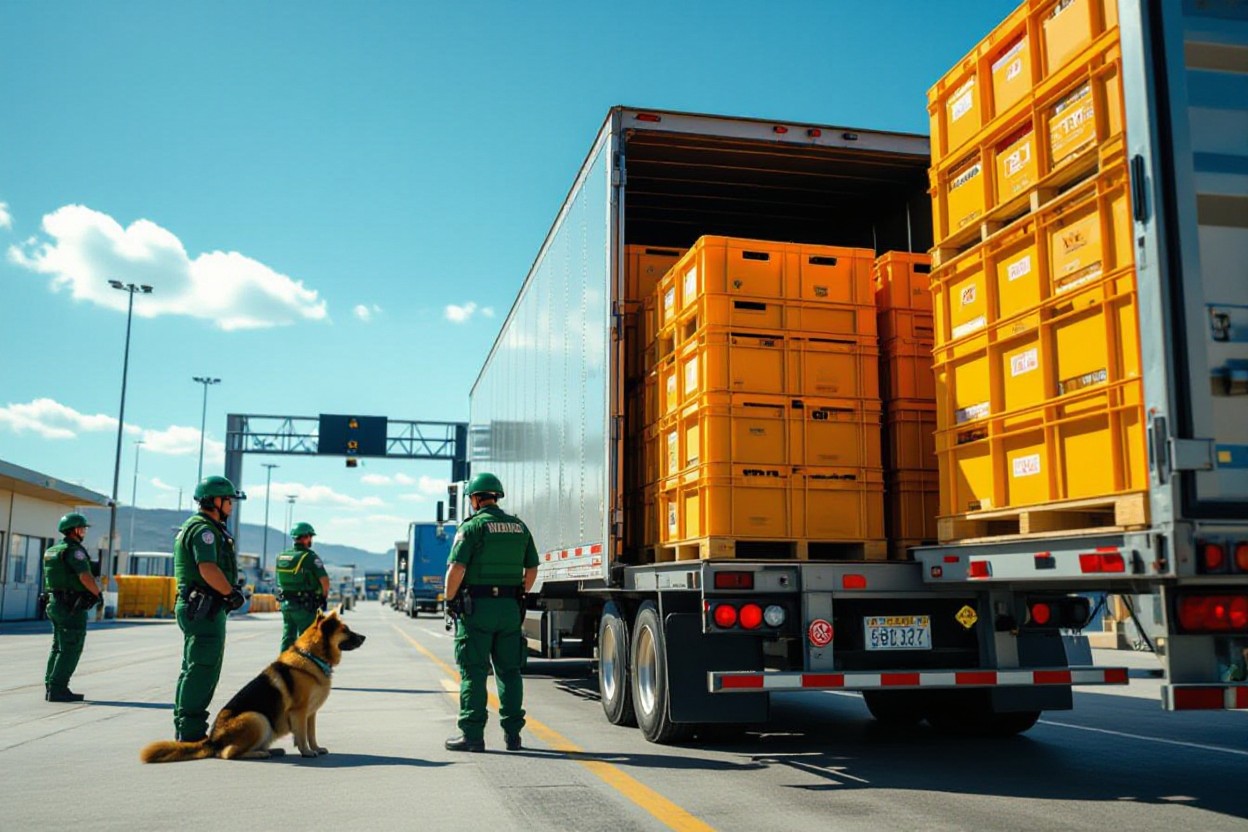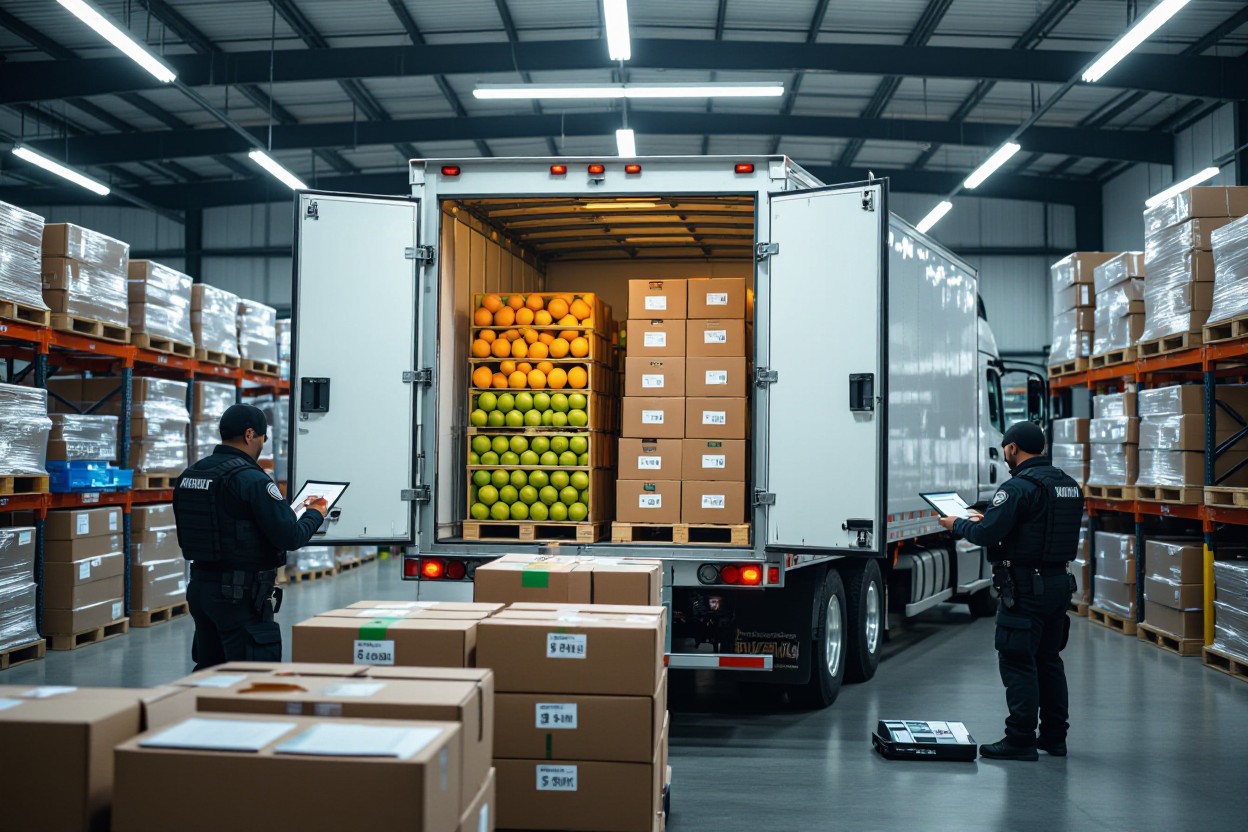On July 6, 2025, U.S. Customs and Border Protection (CBP) officers seized over a ton of methamphetamine hidden inside a commercial truck hauling papayas at the Pharr International Bridge cargo facility in Texas. This seizure highlights the ongoing risks faced at border crossings and the sophisticated methods used to smuggle illegal drugs into the United States.
When the truck arrived from Mexico, it was referred for a secondary inspection involving canine units and nonintrusive scanning technology. Because of these measures, a physical search uncovered 384 packages of methamphetamine weighing 2,571.69 pounds with an estimated street value of $23,647,288. The sheer quantity and value demonstrate the scale of drug trafficking attempts you encounter daily if you work in border security or logistics.
Your understanding of this event is important because it showcases how combining experience and advanced technology allows officers to intercept dangerous narcotics effectively and prevent them from reaching communities. The seized drugs and tractor-trailer were taken into custody by CBP, while Homeland Security Investigations have launched a criminal probe into the incident.
Port Director Carlos Rodriguez emphasized that this large seizure underlines “the dangerous reality of the drug threat our officers face every day.” If you are involved in transportation, warehousing, or border operations, this incident illustrates why vigilance and thorough inspections are crucial to keeping illegal substances off your routes and out of circulation.
Initial Inspection: The Role of Canine Units and Technology
When a commercial truck hauling papayas arrived at the Pharr International Bridge, your attention to detail during the initial inspection made a significant impact. By employing a canine unit alongside nonintrusive inspection technology, you enhanced the chances of detecting hidden contraband without delay. This combination of skilled canine detection and advanced scanning equipment helped to quickly identify potential risks, prompting a secondary inspection that ultimately led to the seizure of over a ton of methamphetamine.
Physical Search: Uncovering the Hidden Methamphetamine
Once the truck was referred for a detailed inspection, your thorough physical search uncovered 384 packages of methamphetamine weighing 2,571.69 pounds. The drugs, concealed within the shipment of papayas, had a staggering estimated street value of over $23.6 million. Your meticulous work not only halted the entry of this dangerous substance into the community but also led to the seizure of the truck itself and launched a major criminal investigation by Homeland Security Investigations.
During the physical search, you played a pivotal role in transforming suspicion into concrete results by carefully inspecting every inch of the commercial vehicle. The discovery of methamphetamine concealed among legitimate cargo highlights both the sophistication of concealment tactics and your expertise in identifying them. Your efforts directly contributed to removing a significant threat from the streets, emphasizing the seriousness of the ongoing drug trade challenge along the border. The value and quantity of the seizure underline just how impactful your diligence is in protecting public safety.
Analysis of the Quantity: What Over 2,500 Pounds Looks Like
When you consider the sheer volume of 2,571.69 pounds of methamphetamine seized, it’s staggering. This amount, spread across 384 packages, would fill an entire tractor-trailer, the size of the one disguised as a papaya shipment. To put it in perspective, such a large haul represents a massive distribution potential, enough to flood illicit markets and fuel addiction. You can imagine the scale of this operation and the significant effort required to intercept it before it reaches your community.
Economic Impact: The Implications of a $23.6 Million Find
The $23.6 million street value of this seizure highlights the enormous financial stakes involved in drug trafficking. For you, this means less availability of methamphetamine on the streets, potentially reducing addiction rates and crime linked to drug abuse. At the same time, this find represents a serious hit to criminal organizations’ revenue, disrupting their operations and forcing them to reconsider their supply chains.
This $23.6 million methamphetamine find is not just a large numeric value; it reflects the power of law enforcement in disrupting dangerous drug networks that threaten your safety. By seizing over a ton of meth from a commercial truck at the Pharr International Bridge, officials have prevented an influx of narcotics into communities. These funds often fuel further illegal activities, so their removal has a direct impact on crime reduction and public health improvement. You benefit from such enforcement actions that stop these profits from empowering dangerous criminals and potentially save lives.

Trends in Drug Smuggling: Current Strategies Used by Traffickers
You should be aware that traffickers increasingly hide illegal substances within legitimate cargo shipments, as seen with the recent seizure of over 2,570 pounds of methamphetamine concealed in a papaya load at the Pharr International Bridge. This method exploits the complexity of commercial freight to evade detection, relying on deceptive concealment and the vast scale of cross-border trade. Understanding these evolving smuggling techniques helps you grasp the ongoing challenges faced in intercepting these high-value shipments.
Law Enforcement’s Evolving Tactics: Adapting to the Threat Landscape
To counter growing smuggling sophistication, your law enforcement agencies are enhancing their approaches by integrating canine units, nonintrusive inspection technology, and targeted secondary inspections. These tactics enabled the recent interception of a $23.6 million meth shipment hidden among produce. By adopting advanced tools and leveraging experience, officers increase their ability to identify hidden contraband within legitimate cargo, keeping you safer from the pervasive drug threat.
In your interactions with freight and border security, you can appreciate how law enforcement’s innovation makes a difference. Agencies like the CBP and Homeland Security Investigations combine technology such as scanners and K9 teams with intelligence-driven inspection protocols to zero in on suspicious vehicles without disrupting legitimate trade flow. This adaptive strategy was demonstrated when authorities uncovered 384 packages of methamphetamine worth over $23 million disguised within a commercial papaya shipment. Their evolving tactics not only disrupt large-scale trafficking operations but also reinforce the integrity of supply chains you rely on daily.

Follow-Up Actions: Criminal Investigation and Next Steps
Following the seizure of more than 2,571 pounds of methamphetamine valued at $23.6 million, Homeland Security Investigations has launched a thorough criminal investigation. You can expect authorities to trace the shipment’s origin and uncover the trafficking network behind this attempt to move drugs concealed as produce. Meanwhile, the seized drugs and the commercial tractor trailer remain in CBP custody. This ongoing inquiry will likely result in arrests and help dismantle similar operations in the future, reinforcing border security and community safety.
Preventative Measures: How This Seizure Shapes Future Operations
This major seizure demonstrates how combining canine units and nonintrusive inspections enhances your ability to detect and intercept dangerous substances. The successful operation underscores the need to continue investing in advanced technology and officer training to identify high-risk shipments disguised within legitimate cargo. By analyzing tactics used in this case, you can improve targeting strategies and response protocols, increasing the chances of stopping such large-scale drug attempts and protecting your ports of entry from similar threats.
Building on this operation’s success, you’ll see a stronger emphasis on integrating multiple inspection techniques, such as canine detection teams paired with sophisticated imaging equipment. These tools, combined with the expertise of CBP officers, create a layered defense that narrows down suspicious vehicles effectively. Incorporating data from seizures like this one allows you to refine profiling methods, anticipate trafficking trends, and allocate resources efficiently. This evolving approach not only disrupts drug flow but also safeguards the supply chain, ensuring that commercial shipments like produce reach their destination without compromising public safety.
Final Words
Summing up, the recent $23.6 million methamphetamine seizure from a commercial truck hauling papayas demonstrates the vigilance and expertise you can expect from U.S. Customs and Border Protection. This operation highlights how advanced technology and thorough inspections work together to intercept illegal drugs and protect your communities. As you follow these developments, it’s clear that ongoing efforts are imperative to disrupt drug trafficking and ensure safety at the borders where you live and work.

